Gentle workouts help calm your anxious mind by naturally regulating your body's stress response system. When you engage in light movement like yoga, walking, or stretching, your brain releases mood-boosting chemicals like endorphins and serotonin while lowering stress hormones like cortisol. Your racing thoughts begin to slow as you focus on mindful movement, and your tight muscles start to release built-up tension. You'll find that consistent, low-intensity exercise can be as effective as medication for mild anxiety. The connection between gentle movement and mental wellness runs deeper than you might think.
Understanding Anxiety and Physical Movement
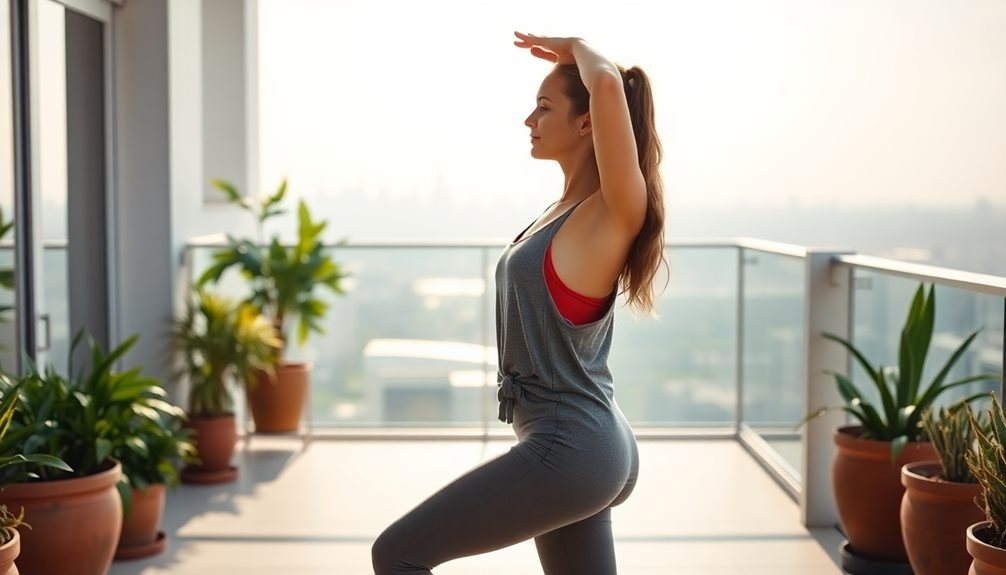
Anxiety sufferers know too well how mental stress can manifest in physical symptoms – from muscle tension to shallow breathing. Your body's fight-or-flight response triggers a cascade of hormones that prepare you for perceived danger, even when no real threat exists. This constant state of alertness can leave you feeling physically and mentally exhausted.
Understanding the connection between your anxious mind and body is essential for finding relief. When you're anxious, your muscles tighten, your heart rate increases, and your breathing becomes rapid and shallow. These physical reactions can create a feedback loop, where bodily tension reinforces mental stress, making your anxiety worse.
That's where gentle movement comes in. Your body needs an outlet to process and release the built-up tension. Unlike high-intensity workouts that can mimic anxiety symptoms and potentially trigger more stress, gentle exercises help activate your parasympathetic nervous system – your body's natural relaxation response.
The Science Behind Exercise Benefits
Physical movement's impact on mental health goes far beyond simple distraction – it creates measurable changes in your brain chemistry. When you exercise, your body releases endorphins, serotonin, and dopamine – neurotransmitters that naturally boost your mood and reduce stress. These chemicals work together to create what scientists call the "runner's high," though you don't need intense running to benefit from them.
Exercise also lowers your body's levels of cortisol and adrenaline, two stress hormones that can fuel anxiety when they're consistently elevated. You'll notice these effects even during gentle activities like walking or stretching.
Additionally, physical movement increases blood flow to your brain, particularly to the hippocampus – a region essential for memory and emotional regulation.
Research shows that regular exercise can be as effective as medication for some people with mild to moderate anxiety. It stimulates the growth of new neurons through a protein called BDNF (Brain-Derived Neurotrophic Factor), which helps create new neural pathways and improves your brain's ability to adapt to stress.
You'll typically start feeling these benefits within 5-10 minutes of starting movement, and they can last for several hours afterward.
Best Gentle Workouts for Anxiety
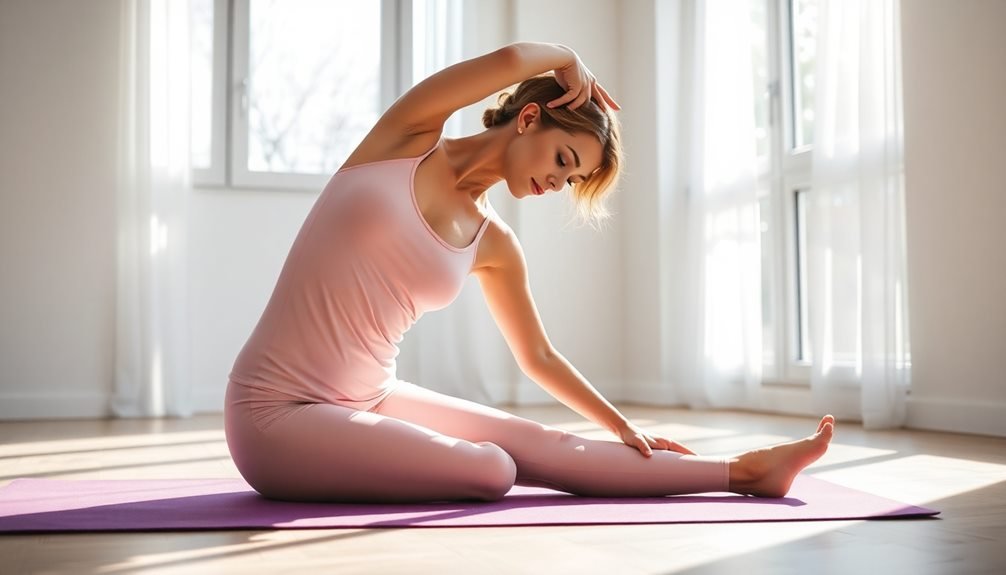
When you're feeling anxious, three gentle workouts can help calm your racing mind and soothe your nerves.
You'll find relief through mindful yoga poses that release nervous energy, peaceful nature walks that ground your thoughts, and gentle pre-bedtime stretches that ease tension.
These accessible movements don't require special equipment or intense effort, making them perfect for moments when anxiety feels overwhelming.
Yoga For Nervous Energy
Nervous energy can find its perfect release through yoga's mindful movements and breathing exercises. When you're feeling jittery, specific yoga poses can help channel that restlessness into focused, calming energy.
Start with Sun Salutations, which combine fluid movements with rhythmic breathing to settle your racing thoughts.
For immediate relief, try Child's Pose, where you'll kneel and fold forward, letting your forehead touch the ground. This position naturally slows your breathing and calms your nervous system.
Forward bends, like Standing Forward Fold and Seated Forward Bend, help reduce anxiety by gently stretching your spine and allowing tension to melt away.
Don't forget power poses like Warrior I and II, which build confidence while burning off excess energy. These standing poses ground you in the present moment and strengthen your body-mind connection.
End your practice with Legs-Up-the-Wall pose, a gentle inversion that reduces stress hormones and promotes relaxation.
Remember to focus on your breath throughout your practice. The combination of deep breathing and gentle movement creates a natural anxiety-reducing effect that can last hours after you've rolled up your mat.
Walking Through Nature Mindfully
A mindful nature walk stands out as one of the most accessible anxiety-busting activities you can do. Unlike structured exercise, you don't need special equipment or training – just comfortable shoes and a willingness to observe your surroundings.
Studies show that combining walking with nature exposure reduces cortisol levels and calms an overactive nervous system.
As you walk, focus on engaging your senses fully. Notice the crunch of leaves beneath your feet, the patterns of sunlight filtering through trees, and the various bird calls around you. You'll find that this sensory engagement naturally pulls your mind away from anxious thoughts and into the present moment.
To maximize the benefits, try maintaining a moderate pace that allows you to breathe comfortably while still getting your blood flowing. When anxious thoughts arise, don't fight them – instead, redirect your attention to physical sensations like your breathing rhythm or the gentle swing of your arms.
Even a 15-minute mindful nature walk can shift your mental state, and you'll often find that your racing thoughts have settled by the time you return home.
Stretching Before Bed
Nightly stretching routines can serve as powerful anxiety-reducing rituals before bedtime. When you stretch your muscles, you're not just preparing your body for rest – you're also releasing built-up tension from the day's stress. Regular bedtime stretching helps lower cortisol levels and increases the production of feel-good hormones that promote relaxation.
Start with these gentle stretches while focusing on deep, steady breathing:
| Stretch | Duration | Benefits |
|---|---|---|
| Child's Pose | 30 seconds | Releases back tension, calms mind |
| Cat-Cow Flow | 1 minute | Improves spine flexibility, reduces stress |
| Legs Up Wall | 2 minutes | Promotes blood flow, relieves anxiety |
You'll notice the most benefits when you maintain a consistent stretching routine. Keep your movements slow and intentional, never forcing yourself beyond comfort. If you're experiencing racing thoughts, pair each stretch with positive affirmations or gentle counting. Remember to dim the lights and create a quiet environment to enhance the calming effects of your stretching session. This mindful practice signals to your body and mind that it's time to shift into rest mode.
Creating Your Stress-Relief Exercise Routine
Building a personalized exercise routine for stress relief doesn't have to be complicated. Start by selecting 3-4 activities you genuinely enjoy, whether it's yoga, walking, swimming, or gentle cycling. Schedule these activities for times when your anxiety typically peaks or when you'll face minimal interruptions.
Begin with 10-15 minutes per session and gradually increase the duration as your comfort level grows. You'll want to exercise at least three times per week, spacing out your sessions to maintain consistent stress management.
Pay attention to how different activities affect your mood and anxiety levels, then adjust your routine accordingly. Include a mix of movement types: cardiovascular exercises like walking help burn off nervous energy, while mindful activities like tai chi improve focus and reduce racing thoughts.
If you're feeling particularly anxious, don't force yourself into intense workouts. Instead, opt for gentler alternatives that match your energy level.
Remember to track your progress using a simple journal or app, noting how you feel before and after each session. This'll help you identify which exercises work best for your specific anxiety patterns and stress triggers.
Mind-Body Connection During Light Exercise
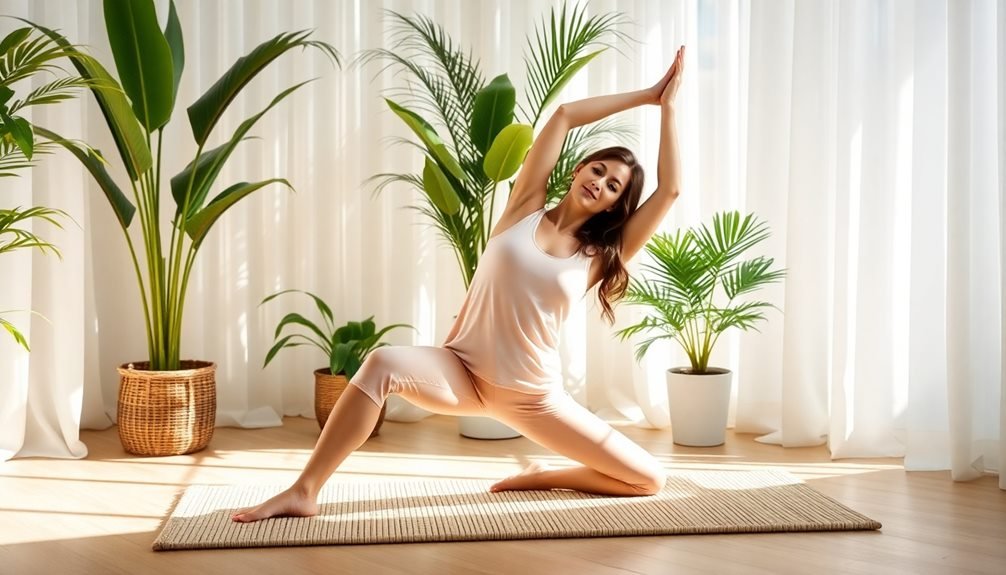
When you're moving mindfully during gentle exercise, you'll notice your thoughts naturally starting to sync with your physical movements.
Your brain releases feel-good chemicals like endorphins and serotonin as you perform repetitive, low-impact activities such as walking or stretching.
This mind-body harmony helps you stay present in the moment while creating a natural buffer against anxious thoughts.
Mindfulness Through Movement Pattern
The mind's ability to stay present transforms simple movements into powerful anxiety-reducing tools. When you focus on each movement pattern deliberately, you're creating a natural rhythm that helps quiet racing thoughts.
This mindful approach to gentle exercise lets you tune into your body's sensations while releasing mental tension.
As you move through each exercise, pay attention to these specific patterns:
- Feel your feet connecting with the ground during walking meditation – notice how each step rolls from heel to toe, creating a steady, grounding rhythm that anchors your thoughts.
- Track your breath synchronizing with arm circles – observe how your inhale naturally rises with upward movements and your exhale flows with downward motions.
- Focus on the gentle stretch and release of your muscles during yoga poses – experience how your body responds to each mindful shift.
Brain Chemistry While Active
Throughout gentle movement, your brain releases a cascade of beneficial chemicals that naturally combat anxiety. As you engage in light exercise, your body produces endorphins, often called "feel-good hormones," which act as natural painkillers and mood elevators.
You'll also experience increased serotonin production, a neurotransmitter that helps regulate your mood, sleep, and appetite.
During gentle workouts, your brain reduces its production of cortisol and adrenaline, two stress hormones that can fuel anxiety. You'll notice your muscles begin to relax as your brain releases GABA (gamma-aminobutyric acid), a neurotransmitter that calms your nervous system.
Your brain also produces more dopamine, which improves your focus and motivation while reducing stress-induced thought patterns.
The combination of these chemical changes creates what scientists call the "exercise-induced calm state." This state isn't just temporary – regular gentle movement can actually reshape your brain's neural pathways, making you more resilient to anxiety over time.
You don't need intense workouts to trigger these benefits; consistent, moderate activity is enough to maintain this positive brain chemistry balance.
Building Long-Term Mental Wellness Habits
Creating lasting mental wellness habits requires more than just sporadic exercise sessions or temporary lifestyle changes. You'll need to establish a consistent routine that combines gentle physical activity with mindful practices to rewire your brain's stress response patterns.
Start by selecting activities that you genuinely enjoy and can sustain long-term. Whether it's yoga, swimming, or walking, choose movements that don't overwhelm your already anxious system. You'll find that consistency matters more than intensity when building mental resilience.
To create a sustainable wellness practice, visualize these key elements:
- A peaceful morning ritual that begins with 10 minutes of gentle stretching beside your bed, letting sunlight stream through your window.
- A midday break where you step away from your desk for a 15-minute walk, focusing on the rhythm of your feet touching the ground.
- An evening wind-down routine that includes 5 minutes of deep breathing exercises while sitting in your favorite chair.
Remember that you're not just exercising your body – you're training your mind to respond differently to stress triggers. Make these practices non-negotiable appointments with yourself, treating them as essential as any other daily commitment.
Frequently Asked Questions
Can Gentle Workouts Help With Panic Attacks During Social Situations?
Yes, you'll find gentle exercises can help manage panic attacks in social settings. Try deep breathing, light stretching, or walking before social events – they'll lower your stress hormones and boost confidence naturally.
Should I Exercise Before or After Taking Anxiety Medication?
You should consult your doctor about timing exercise with anxiety medication. Generally, it's safe to exercise either before or after, but your specific medication might have unique recommendations for best timing and effectiveness.
What if Gentle Exercise Makes My Anxiety Temporarily Worse?
If exercise increases your anxiety, try shortening your sessions or reducing intensity. Start with just 5 minutes and slowly build up. You'll likely find your tolerance improves as your body adapts over time.
How Long Does Post-Workout Anxiety Relief Typically Last?
You'll typically experience anxiety relief for 2-4 hours after working out, but regular exercise can create longer-lasting effects. If you exercise consistently, you'll notice reduced anxiety levels throughout your daily life.
Can I Combine Gentle Workouts With Other Anxiety Therapies?
You can definitely combine gentle workouts with other anxiety treatments like therapy, meditation, or medication. They'll complement each other well, enhancing your overall anxiety management and creating a more thorough approach to mental wellness.
In Summary
You'll find that gentle exercise is one of the most effective natural remedies for anxiety management. When you make light movement a consistent part of your daily routine, you're not just helping your body – you're giving your mind the tools it needs to stay balanced. Start small, stay consistent, and watch how these simple physical activities transform your mental well-being over time.
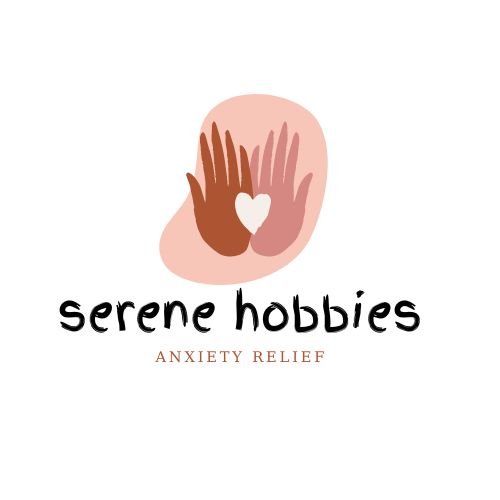
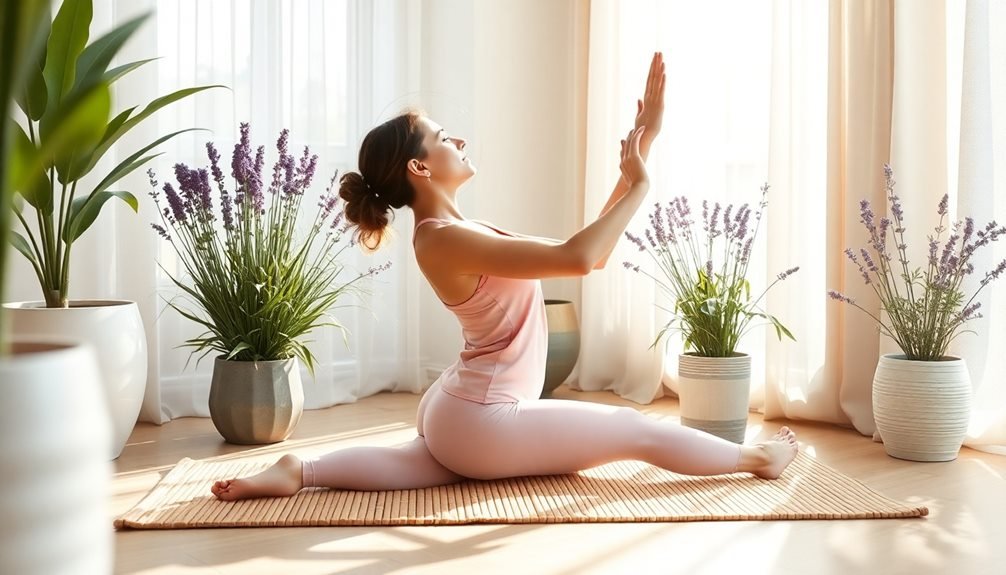
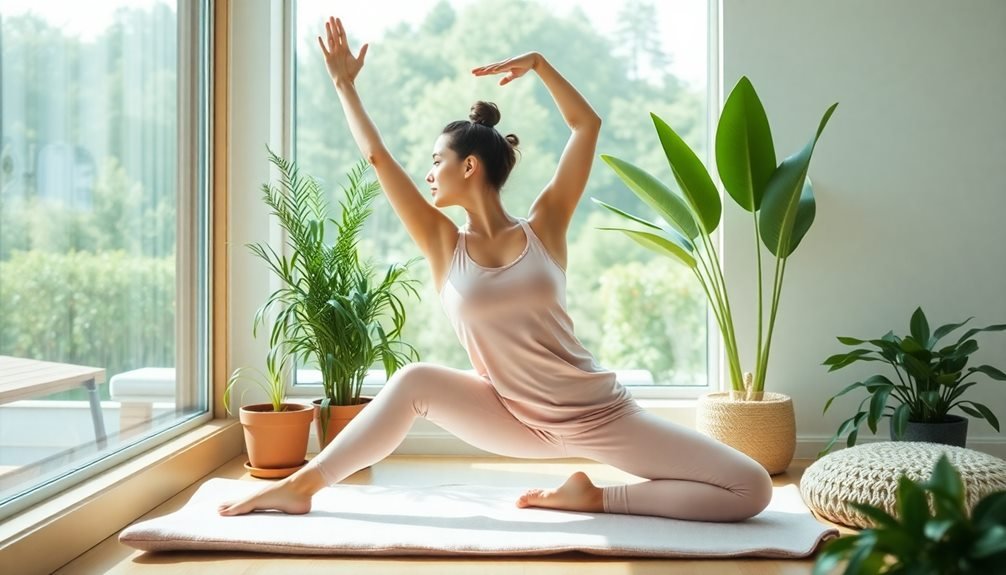
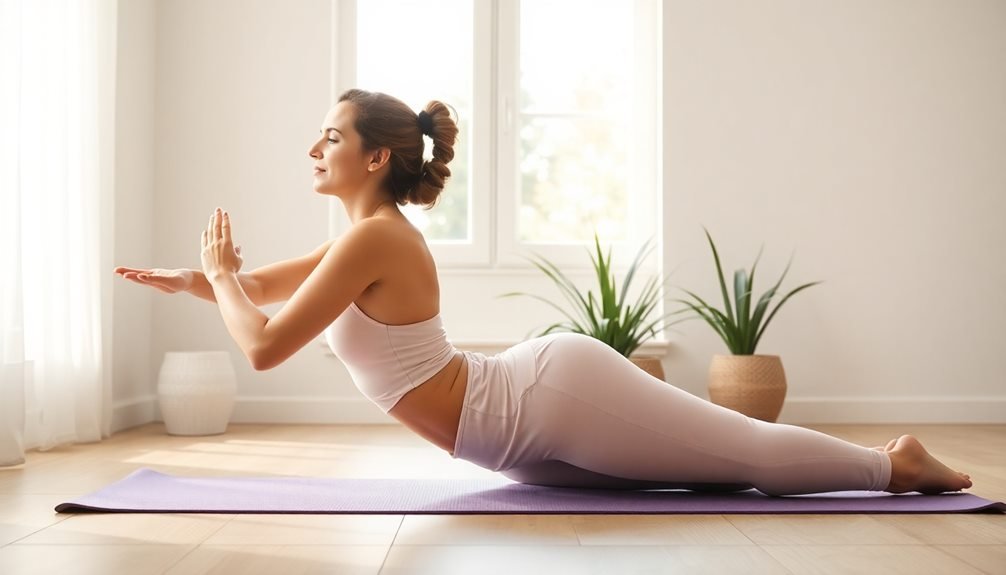
Leave a Reply